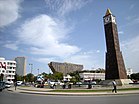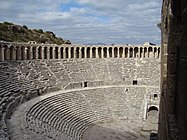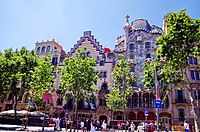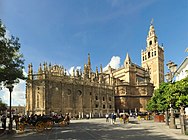New Tyria
This article is incomplete because it is pending further input from participants, or it is a work-in-progress by one author. Please comment on this article's talk page to share your input, comments and questions. Note: To contribute to this article, you may need to seek help from the author(s) of this page. |
New Tyria
| |
|---|---|
| The City of New Tyria | |
|
Clockwise from top: New Tyria cityscape, Hall of Workers' Councils, Šidduni Square, The Latin Ampitheatre, National University of Tyreseia Wechsler Library | |
| Nicknames: The Big Olive, NTC | |
| Country | |
| Metropolis | Tyria |
| Region | Greater Tyria |
| Municipal Councils | List
|
| Rebuilt | 180s BCE |
| Government | |
| • Type | Urban association |
| • Body | Tyria Multi-Municipal Council |
| Area | |
| • Capital city | 1,918 km2 (741 sq mi) |
| • Metro | 30,595 km2 (11,813 sq mi) |
| Population (2020) | |
| • Capital city | 8,764,231 |
| • Density | 4,600/km2 (12,000/sq mi) |
| Time zone | UTC+1 (Central Scipia Time) |
| Postal code | SH-001 to SH-999 |
| Area code | 11 to 19 |
New Tyria is the capital and largest city in the Workers' Federation of Tyreseia, with a population of 8,764,231 as of the 2020 Census. It is located along the Tyrian Bay, the Heshek River and the Periclean Sea.
Though the city lacks official legal status as the nation's capital city, New Tyria has nevertheless played an outsized role in Tyreseia's history, politics, and culture. Most of the nation's governmental institutions and unions are headquartered in the city, along with the world's embassies and diplomatic missions. Much of the administrative apparatus of the Rubric Coast Consortium is also based in New Tyria. The city also serves as a transportation and service hub, playing host to the nation's only international airport and its largest railway stations.
History
Historical affiliations
Principality of New Tyria, 1416-1832
Tyrian Republic, 1832-33
Frederican Restoration, 1833-1848
Second Tyrian Republic, 1848
Final Monarchy, 1848-1861
First Tyreseian Republic, 1861-1883
In the aftermath of a devastating earthquake in 191 BCE, the ancient and eponymous capital city of the Tyrian civilization, Tyria, was largely destroyed. At the time, the Latin Empire had recently concluded its intervention in the civil war between the merchant houses of Hiram and Eshmun. As the Latin-backed Hiramites had won, the legions present in the region were seeking a place to establish a new Hiramite client capital. The other major Tyrian city-states, including the Hiramite home base of Tsabratan, had suffered even greater destruction from war, pestilence, famine and the earthquake. As such, much to the Hiramites' chagrin, the capital site was selected a few kilometers east of old Tyria, along the X River. Much rubble from the old city was repurposed in building the new, with some ancient Tyrian monumental structures being cut down and rebuilt as they once were. Through the recycling of building material and whole buildings alike, the core of New Tyria was established in around 179 BCE, with the harbor and Temple of Jupiter (a reconstructed temple to Ba'al Hammon) as the focii of the design. The process of ignoring the Hiramites' choice of capital and desecrating Tyrian religious sites proved too much for many to bear, and many Hiramites rose up in revolt in 178 CE. The revolt, concentrated in the west and featuring some Eshmunites fighting alongside their former sworn enemy, was swiftly put down as numerous Latin forces had arrived to aid in New Tyria's construction and in securing their new client kingdom. In the aftermath, the region now known as Tyreseia was quickly transformed into a more directly-administrated province of the Empire, with the once-great Houses of Eshmun and Hiram being forcibly dissolved.
During the Latin period, the city saw a quick explosion in growth, seeing many peoples of both Tyrian and Latin descent migrating into the city. Other minority groups, including the city's first Jewish populations, ended up within New Tyria's walls as the combination of riverine transport, maritime trade and Latin financial support made the city grow rapidly in just a few centuries. Even after the Latin withdrawal, the city continued to grow, coming under the control of the eponymous Tyrian Republic. Formed after the collapse of Latin authority, the Republic was ruled by a collegium of influential elders and merchants, governing the city-state's affairs. The period following the Latin withdrawal saw alternating stages of stagnation and minor growth until the early 10th century. The concurrent onset of the Coptic Golden Age saw the headquarters of the Coptic Church move from the ghost town of Koptos to the then-outskirts of New Tyria. The epicenter of secular and religious learning was centered on the city, leading to the construction of the Bibliotheca Tyriensis, or the Tyrian Library. This library, and later associated Collegium, survived several invasions through the centuries and became the National University of Tyreseia.
Geography
The site of New Tyria lays on strategic ground. The city lies along both the Periclean Sea coast and the X, a large delta branch of the Heshek River. This branch was artificially widened by successive Latin, medieval, and early-modern projects, making it easy to transport goods and people from the Periclean down the channel to the Heshek and vice versa.
Climate
Government
Economy
Infrastructure
Transportation
New Tyria is bound together by numerous forms of mass transit. The vast majority of denizens rely on a vast and intricate network of buses, light rail, subway lines, and commuter rail to navigate both the city center and its environs. The city limit is surrounded by two consecutive rings of highways, but these see little personal traffic compared to mass transit. The city is considered a regional transport hub, with most intercity rail lines in Tyreseia ultimately terminating in the city's central stations. New Tyria also plays host to the country's largest passenger airport, New Tyria-Celiceten International Airport. The city's extensive freight harbor is complemented by ferry terminals for destinations such as Gran Aligonia and even Lihnidos, and has even played host as a terminus for trans-Ozeros cruise services.
Rail is far and away the most frequently-used method of transit in New Tyria. All subway lines in the Greater Tyria area fall under the operation of the New Tyria Metro Service (Metro dja Tiria Nova, MdTN). One of the oldest metropolitan systems in the world, the MdTN first began operations between the Palachu Naxunalu and what is now Xidduni Square in 1890. Today, the Metro subway network comprises 12 lines with a total of 212 stations, and a total system length of around 193.35 kilometers. The network primarily exists to connect key locations in the city center, as well as to connect the city's main intercity stations and connect commuter line termini with city outskirts. In addition to the subway network, the MdTN manages the tram, bus, and light rail systems in the Parradu Xidduña ward; due to the high concentration of government buildings and important structures and lack of significant housing in the area, the local council simply cannot support the upkeep of local transit on its own. Finally, the MdTN also operates the Faucu (Falcon) surface rapid express line from Celiceten Airport to the Esdachu Gadir, New Tyria's main westbound intercity station.
Commuter rail in New Tyria, along with aboveground heavy rail, falls under the operation of the state railway corporation, FerruTir. These lines bring commuters from outlying areas in the city to several key stations around the edge of the city center; from there, passengers can seamlessly transition to Metro lines or other local transit to reach their destination. All public transit in the New Tyria area operates on a unified fare system; tickets can either be purchased for journeys or integrated-chip cards can be used to pay fares. Local companies and councils often pay for employees or residents to obtain free or reduced fares as a benefit of work or residence. Trams in the rest of the metropolitan area, along with bus systems and other forms of light rail, fall under the responsibility of local councils to operate and manage. The federal government of Tyreseia incentivizes the local wards to standardize their transit network; even still, services like trams and buses typically only serve smaller areas within singular wards, linking residents with services and locations within their ward or to commuter rail/metro stations. New Tyria is also an important intercity rail hub, with Esdachu Gadir serving as a terminus for all rail lines coming from the west and Esdachu Arramu serving as the terminus for all rail lines coming from the south and east. Important international rail connections also terminate in New Tyria, such as the West Scipian Railway in Esdachu Gadir and the Taɣlamt high-speed rail service in Esdachu Arramu.
Education
Culture
Sports

Cuisine
Entertainment
Landmarks
The city is dotted with landmarks, many of which reflect the extravagant building projects of the Princes of New Tyria in the mid-to-late-19th centuries. Much of the city's modern buildings of note, in terms of both public architecture and private, either embody the styles of Belisarian Neoclassicism or later works of the Brutalist school. A notable exception includes the Latin Ampitheatre on the southeast rim of the city, dating to late Antiquity and serving as one of the most well-preserved examples of an ancient public ampitheatre. On the other end of the spectrum is the covered walkways and cloistered alleyways of the Jewish Quarter, which remain largely unchanged from the Medieval era. As the capital and most populous city in Tyreseia, New Tyria possesses numerous landmarks that denote its status as a hub for bureaucracy, arts, culture, trade, and religion. The Palachu Naxunalu (National Palace), begun in the 1850s as a palace and seat of government for the New Tyrian princes, became a symbol of princely decadence during the Resurgencha and the site of many a riot and attempted coup. Following its occupation, it became the seat for the turbulent Tyreseian Republic's Provisional Government. Work controversially continued on completing the building, and strongman Azmelqart Šidduni famously stormed the Palachu with his loyalist soldiers in the 1883 Revolution. The nearby Arcu dji Triumfu (Arch of Triumph) was consecrated in 1928 to celebrate both that year's World's Fair and the 45th anniversary of the 1883 Revolution. Constructed with a deliberate mixing of Neoclassical style and design cues from indigenous and Caliphal flourishes, the Arcu was meant to pay tribute to the many cultures and polities that had fused to create the modern Tyreseian identity. Meanwhile, the Museu djas Bejas Arzas (Museum of Fine Arts), the premier art museum in the nation, was installed in the former Princely Court Tribunal halls on the orders of the Provisional Government in the 1870s, following the seizure of numerous private collections and their merger with public galleries around the city. Art may be found around the city, not just in museums: the neighborhood of Paricu Macuaveňu (Mahalb Cherry Park) has gained international fame for its eccentric, colorful houses constructed in the turn of the century as restrictions on avant-garde expression and extravagance subsided following Šidduni's departure from politics.
With the city lying at the confluence of so many trade routes, a multitude of religions have expectantly spread their influence in the city, to the point that shrines, churches, synagogues, temples, and other houses of worship of a dozen religions or more dot the city's streets. While the city of Oyat (formerly Coptia) is the nominal home of the Coptic Church, one of its largest churches, the Church of Saint Augustus (Ecueja dji Sampu Juguxu). Constructed by the father of the same architect as the Arcu dji Triumfu as a massive renovation on the original medieval structure, the new church incorporates elements of traditional Rubricine architecture along with updated forms of much of the original Gothic design, unusual for the region's architectural styles.
Sister cities
New Tyria is paired with numerous sister cities:
 Aquillican, Zacapican
Aquillican, Zacapican Innsboro, Ottonia
Innsboro, Ottonia K'alak Muul, the Mutul
K'alak Muul, the Mutul Kasharija, Alanahr
Kasharija, Alanahr Kogaya, Tsurushima
Kogaya, Tsurushima Kopiona Poi, Pulau Keramat
Kopiona Poi, Pulau KeramatMaktarim, Talahara
In addition, all the capital cities of the member states of the Society of Latin Peoples and States participate in the Capital Friendship Program, which functions in a similar vein to sister cities.
Maktarim, in particular, shares a close relationship with the city. With Tyreseia and Talahara's shared border, their ideological proximity, historical friendship and extremely similar capital populations, Maktarim and New Tyria are often imagined as the "twin sister cities" of the Periclean.















